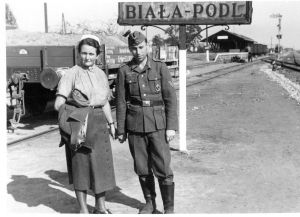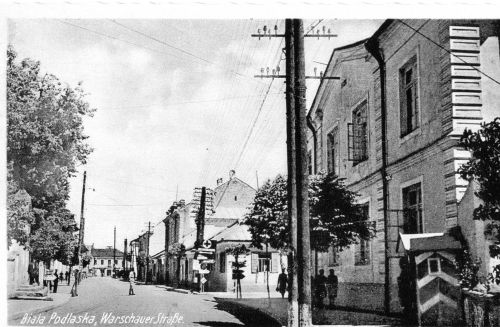Biala Podlaska

Nurse with German Soldier at Biala Podlaska Station
Biala Podlaska is located approximately 62 miles north-northeast of Lublin. In 1939, approximately 7,500 Jews were registered in the town, most of them working as traders, craftsmen, or artisans. German troops first occupied Biala Podlaska on 13 September 1939. Under the terms of the Molotov-Ribbentrop Pact, the town was originally assigned to the Soviet Union and units of the Red Army took over from the Germans on 26 September 1939. However, this was a short term occupation and the Soviet troops retreated in early October 1939, and Biala Podlaska returned to German control. Approximately 600 Jews from the town fled with the Red Army into territory held by the Soviets.
Shortly after regaining control of Biala Podlaska, the German authorities, assisted by local Poles, wearing armbands, started to seize Jews from the streets for forced labour. Hundreds of Jews were forced every day to clear rubble from buildings damaged during the German bombardments at the time of the invasion and to clean public buildings and German barracks. On 26 October 1939, under the new civil administration, the town became part of the Distrikt Lublin, serving as the centre of Kreis Biala Podlaska. From 29 November 1939, until 20 December 1942, the Kreishauptmann was SA- Standartenführer Hubert Kuhl, who previously had worked in the Reich Propaganda Ministry. Other German offices in the town included posts of the Criminal Police, the Gestapo, and the Sicherheitsdienst (SD), all of these forces were subordinated to the Commanding Officer of the Security Police and SD (KdS) in Lublin. These offices were subsequently consolidated into the so-called Grenzpolizeikommissariat (Border Police Office). Serving as head of the Gendarmerie were Rudeck, Christoph Konig, and Becker. Between October 1940 and the end of 1943, part of Police Battalion 307, was also based in Biala Podlaska.
In November 1939, a Jewish Council (Judenrat) under the leadership of Izaak Pirzyc was established. The Judenrat attempted to maintain pre-war communal activities, for example, organising a public kitchen for the needy and a Jewish hospital. In addition, the community maintained two public libraries. From the autumn of 1939, the German authorities imposed a series of discriminatory measures against the Jews. In November 1939, Jews were forbidden to leave the town without permission; on 1 December 1939, all Jews were obliged to wear armbands bearing the Star of David. German officials robbed the Jews, confiscated their businesses, imposed taxes and demanded large ‘contributions.’ The local Housing Office began requisitioning Jewish homes for non-Jews. Local collaborators such as Mayor Antony Walewski and his deputies S. Szcypanski and Bajlicki actively participated in the confiscation of Jewish apartments. At the end of 1939, approximately 2,000 Jews who had been deported by train from Suwalki and Serock arrived in Biala Podlaska. They were only allowed to bring with them small amounts of luggage. Some were accommodated in Jewish apartments and others were housed in the synagogues and prayer houses, which were very cold in winter. Their presence severely aggravated the poor living conditions in the town, and some Jews departed shortly afterwards to Warsaw. In early 1940, approximately 500 Jewish prisoners of war (POW’s) who had served in the Polish army were marched on foot from Lublin to Biala Podlaska, where they were placed in a POW camp located in a barracks on the road towards Brest Litowsk. Subsequently, some of these Jewish POW’s managed to escape from the camp and join other Jews in Biala Podlaska. On 15 May 1941, most of the Jewish Prisoners of War in the camp were transferred to Konskowola, which is near Pulawy, in the Lublin District. In March 1940, the Germans ordered the systematic registration of all Jews available for work. These Jews were forced to work mainly in factories and workshops in Biala Podlaska and the adjacent areas. In addition some seven labour camps were established at construction sites. For example some Jews worked on expanding the airfield at the pre-war airplane manufacturing facility, where since the occupation the Luftwaffe had established a military base. Jews were paid between 3 and 10 zloty per day for forced labour, depending on their skills. In July 1940, all the Jewish men were assembled, and a number were selected to be sent to forced labour camps near Belzec. After a few months, the Judenrat was able to secure their return. In December 1940, approximately 1,000 Jewish deportees arrived in Biala Podlaska from Mlawa. The expectation of more deportees arriving in early 1941, caused the German authorities to consider establishing a Jewish Quarter in Biala Podlaska, as well as relocating the Jewish deportees to labour camps. However, the arrivals did not arrive in the town until March 1941.With the arrival of more than 1,000 Jews from Krakow, the Jews were dispersed to other places, for example on 22 March 1941, some 550 of the deportees from Krakow were sent to Piszczac, and elderly Jews from Biala Podlaska were sent to Podedworze- Opole. A few weeks later by April 1941, another 607 Jews from Krakow also shared the same fate. In the late spring of 1941, as the Germans began to prepare for the invasion of the Soviet Union, many Jews were requisitioned for the construction of roads, barracks for the German troops and fortifications, and other projects. A large number of Jewish women worked on the Halasy estate, which had formerly belonged to Duke Potocki. Also around this time the so-called ‘Vineta’ barracks camp for Jewish workers was also established in Biala Podlaska. In June 1941, the German authorities introduced a series of measures to fight the spread of typhus, which severely affected the Jews. For example, all trade between ‘Aryans’ and the Jewish population was forbidden, and non-Jews were forbidden to enter Jewish houses. These regulations restricted the Jews ability to obtain food, causing prices to increase even further. The typhus epidemic became particularly serious in the winter of 1941 – 1942, resulting in a number of deaths within the Jewish community. In the meantime many of the ‘voluntary deportees’ returned to Biala Podlaska, as well as new arrivals. This situation and the typhus epidemic probably led to Kreishauptmann Kuhl to establish a more formal Jewish ghetto in Biala Podlaska and some accounts date the establishment of the ghetto in the summer of 1941.

Biala Podlaska - Warschauer Strase (Tall Trees Archive, UK)
A Jewish Police unit was established to maintain order in the Jewish ghetto in the autumn of 1941, and by the summer of 1942, its number had increased to 50 men.In the autumn of 1941, the office of the Judenrat was moved to Grabanowska Street with the aim of the transferring everything Jewish into the ghetto area, however the Jewish Social Self-Help (JSS) records indicate that it was not until April 1942, that the Kreishauptmann Kuhl ordered the JSS to move its community kitchen from Stadtplatz 19 into the ghetto area, and this move was accomplished by June 1942. The Jewish ghetto was located in the centre of the town, in the following streets, Grabanowska, Janowska, Prosta, and Sadowa. In the spring and summer of 1942, the SS and Gestapo conducted mass shootings of Jews in the forests surrounding Biala Podlaska. On 6 June 1942, the terror of resettlement reared its ugly head, the office of the Kreishauptmann ordered that all Jews without work identity cards from the Arbeitsamt (labour office) had to report for resettlement on 10 June 1942. After receiving the order, many Jews disobeyed the instruction and fled into the forests. On 10 June 1942, approximately 700 Jews assembled at the synagogue courtyard at 5.00 a.m. More were gathered during the course of the day, with the aid of the Jewish Police and they were handed over to members of the Sonderdienst (ethnic German police) at the railway station. The next day, the victims were loaded into freight cars and taken to the Sobibor death camp. In total 3,000 Jews from Biala Podlaska were deported to their death in Sobibor that day. On the night of 4 August 1942, a group of 19 Jews were shot; the area of the Jewish ghetto was reduced following the deportation ‘Aktion’ and the Judenrat issued instructions on 7 August 1942, that the Jews had until 6.00 a.m. the following morning to move into the reduced area. Six days later on 12 August 1942, the German Gendarmes assisted by Ukrainian auxiliaries carried out a wave of kidnapping of Jewish men. The Judenrat complained to the German authorities, and as a result approximately 400 Jews, including most of the members of the Judenrat, were deported to the Lublin concentration camp, and from there most of them were sent to a labour camp at Golab, where they worked on the railroad. On 22 September 1942, the day after Yom Kippur, a German official from Biala Podlaska gave the Jews in the nearby Konstantynow ghetto until 25 September 1942, to report to the ghetto in Biala Podlaska, those who didn’t were marched to Biala Podlaska.
On 26 September 1942, the Gestapo liquidated the Biala Podlaska ghetto. On the eve of the ‘Aktion,’ the ghetto was surrounded and the ghetto inhabitants were herded to the New Market Square. Except for some Jews who were sent as a forced labour detail to the Malzszewicze Duze airfield, all the Jews who were rounded up were deported to Miedzyrzec Podlaski, where they entered the ghetto there. The registration cards for 1,200 Jews transferred from Biala Podlaska to the Miedzyrzec Podlaski ghetto on 26 September 1942, can be found in the records of the International Tracing Service. Jews in Biala Podlaska who did not obey orders and were caught in hiding places were shot immediately. The Gestapo also shot all the patients and the two nurses in the Jewish hospital. In total, the Gestapo, assisted by the Gendarmerie and local collaborators, shot approximately 100 Jews in the town, burying the bodies in the Jewish cemetery. The Germans searched for those Jews in hiding for several days and on 28 September 1942, the mayor of Biala Podlaska prohibited the local population from entering the ‘former Jewish quarter,’ and threatened that looting would be punished with the death penalty. On the following day, another announcement by the mayor instructed local inhabitants to intercept Jews and hand them over to the Gendarmerie.
The Jews deported from Biala Podlaska were held in the Miedzyrzec Podlaski ghetto for several days. On 6 October 1942, additional Jews from labour camps in the vicinity were assembled at the Biala Podlaska railway station. Their train made a stop at Miedzyrzec Podlaski, and picked up the Jews who had been deported earlier from Biala Podlaska. In all some 4,800 Jews were deported to the Treblinka death camp, where they perished. Some of the Jewish labour camps in and around Biala Podlaska continued to function for several more months. One group of Jewish workers that had remained in Biala Podlaska was employed by the Gestapo to clear out property from the former ghetto area. They also had to demolish the synagogue and other Jewish religious buildings. The Wehrmacht camp was liquidated during mid-December 1942 and the Jews remaining were either sent to other camps or liquidated. On 26 July 1944, Soviet troops entered the town of Biala Podlaska, and out of the 7,000 Jews who lived in the town, in 1939, only about 300 managed to survive the German occupation.
Sources:
The Encyclopaedia of Camps and Ghettos 1933-1945, USHMM, Indianna University Press Bloomington and Indianapolis 2012 Y. Arad, Belzec, Sobibor, Treblinka – The Aktion Reinhard Death Camps, Indiana University Press, Bloomington and Indianapolis 1987Photographs – Chris Webb Archive, Tall Trees Archive UK
© Holocaust Historical Society 2020

